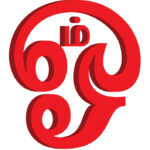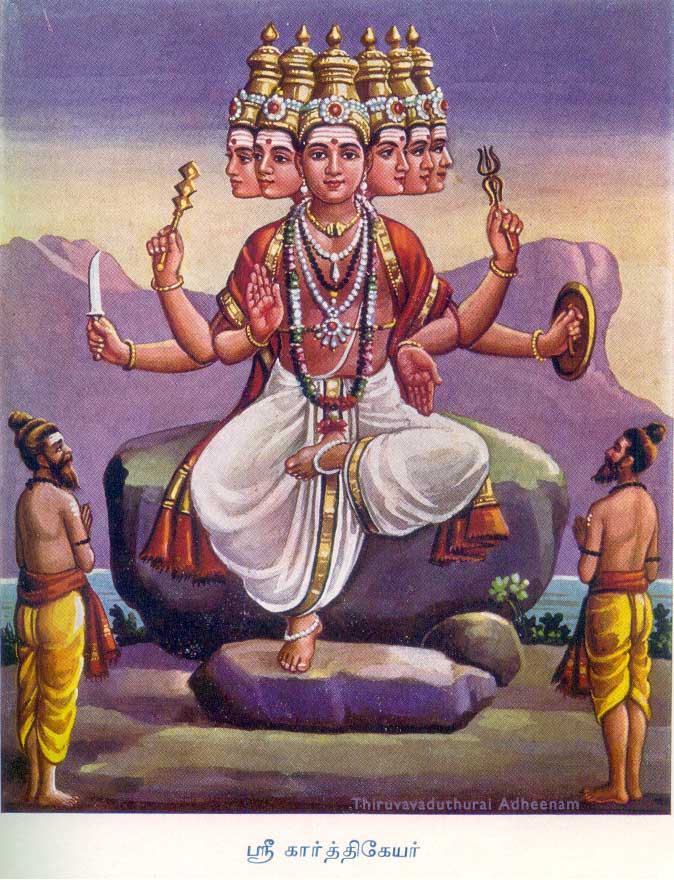From Temple Cars of Medieval Tamilaham
(Madurai: Vijay Publications, 1989) by Raju Kalidos
Chapter 1.26 “The Iconography of Murugan”
Murugan, the second son of Siva and Parvati, is variously known as Subrahmanya, Shanmukha, Karttikeya, Skanda, Devasenapati, Śikhivahana Saravanabhava, etc. The cult of Murugan was a well developed one ever since the Cankam period in Tamilaham. The iconography of Subrahmanya is elaborated at length in the Kumaratantra and Śritattvanidhi. In temple cars Murugan is a very popular figure and events pertaining to the Skanda Puranam and other puranams are well represented (4.4% 123/2795). In the present work the multifarious aspects of Subrahmanya’s iconography are brought under the following heads: S’ikhivahana, forms relating to Puranic events and miscellaneous forms.
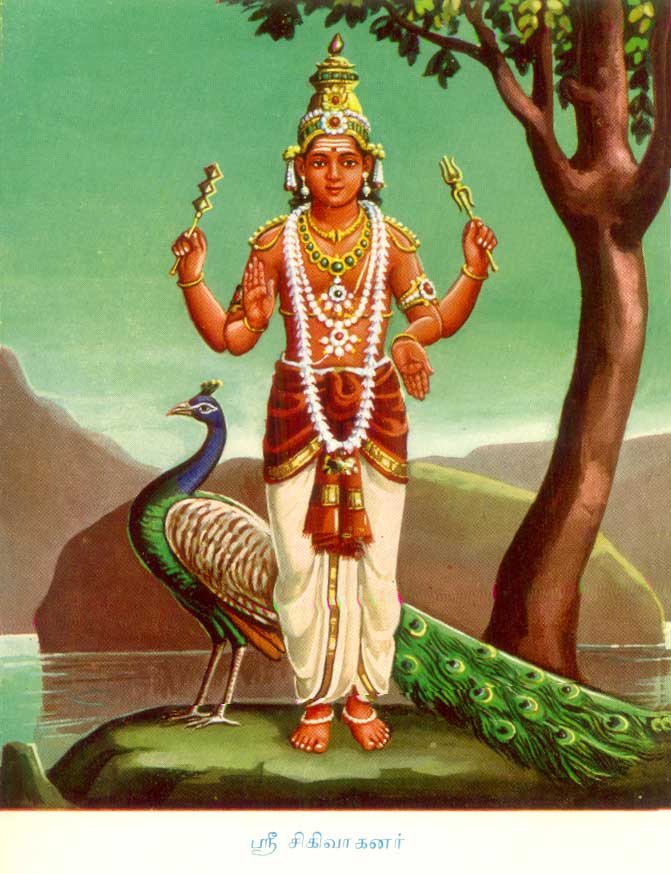
Above: As Śikhivāhana, Subrahmanya has one face, three eyes and four hands. The hands bear the abhaya mudra, varada mudra, sakti and vajra. His peacock vehicle is called Indranilaratha.
1.26.1. Śikhivahana
Śikhi or mayura (mayil in Tamil) means peacock. Vahana is a form in which Subrahmanya is seated on a peacock. The peacock was associated with Karttikeya since the Gupta period as noted in Kalidasa’s Raghuvamsa (5th century AD). 203 As Śikhivahana, Subrahmanya has one face, three eyes and four hands The hands bear the abhaya mudra, varada mudra, sakti and vajra.His peacock vehicle is called Indranilaratha. 204 The Śritattvanidhi associates the other forms of Murugan like Karttikeya, Shanmukha and Desika with the peacock. They are ten, twelve and six-handed respectively.
A number of panels (nos. 970, 971, 977, 987, 989, 998, 1001. 1011, etc.) depict the six headed and twelve armed Shanmukha or Satanana or Arumukha. He bears the following objects in his hands: a lance called sakti, arrow, sword, disc, noose, abhaya mudra (in right hands). 205 His consorts, Jaya (Devasena) and Vijaya (Valli), stand to the left and right respectively. Certain specimens depict Shanmukha in agreement with the sastraic injunctions. In rare cases (nos. 970 and 998) three faces alone are depicted while the hands are twelve. In a few specimen (nos. 977, 939 and 998) Jaya and Vijaya are present. They are either standing on either side of the peacock or seated on the bird along with Shanmukha. In a piece (no.996), Shanmukha is seated on the peacock in sukhasana while his devis are seated on his thighs. They hold a lotus in one hand while the other is made to rest on. Shanmukha’s thigh. The peacock stands straight facing with its wings spread on both sides. It remarkably compares with the Gupta image from Muzaffarpur (now in the Patna Museum). 206 The expanded puncham (plumage) is depicted like a prabhamandala behind the panel. 207
Another popular form of Śikhivahana is Skandamurti. He has four hands which bear the thunderbolt, bow, arrow, and the lance.He is carved on the model of Tripurantaka. 208 Valli and Devasena stand on either side. A number of specimens (nos. 975, 985, 988, 990, 991, 995 and 999) depict Skanda in Tripurantaka pose.
Another form of Śikhivahana is Kārttikeya. He has six faces and six hands, according to the Kumaratantra, and one face and ten hands, according to the Sritatvanidhi. 209 A rare specimen (no.1002) depicts Karttikeya with five faces and ten hands. In another. piece (no. 1012), Subrahmanya is seated on peacock with the left leg in utkutika pose. The leg is suspended below from behind the bird with the result that the foot alone is visible. 210 The front right hand holds the lance vertically while the front left hand is placed on the knee of left leg. He is wearing his characteristic ekāvali necklace. In some. panels (no. 994, etc.) Subrahmanya is depicted as a two-handed standing figure. The peacock waits for him. The right hand holds the lance as placed on earth. The other hand is held in katyavalambila pose. In one specimen (no. 981) the peacock is found lying in front of the standing Subrahmanya. In this form, he is known as Velayudha (one who bears the vel ‘lance’). 211
1.2.6.2. Puranic events
This is a very popular theme (56% 69/123) in the temple cars. It includes a number of forms of Murugan such as Saravanbhava, Arunarudamurti, Brahmasasta, Gurumurti, Tarakari, Krauncabhedakamiirti, Valli-kalyanasundara, Mottayandi and some portraying puranic events.
Another from of Murugan represented in the temple cars is Arunādūmūrti (No. 1018 and 10l9). 212 In this form Murugan is said to have subdued a fierce goat with the help of Vīrabāhu and made it his own vāhana. In one (No. 1019) Brahma is found performing a sacrifice He is bearded and wears a jatāmakuta. A dreadful goat with curved horns is merging from the sacrificial pit. In the same panel Murugan is found riding on the goat after having overpowered it.
Brahmaśāsta is a form of Murugan by which he is said to have punished the God of Creation. Brahma, for not knowing the meaning of pranava mantra. Three specimens (Nos. 1020 to 1022) related to this episode are available. In one (No. 1020) the three faced Brahma stands folding the front two hands in anjali hasta in front of Murugan who has one face and four hand. Murugan is a handsome lad while Brahma is ripe in age. The objects held by Muruga in the two back hands are not clear…vessel and rosary. 213 Then Brahma is found confined within the bar. The imprisoned Brahma also three faced and four handed. In the back hands he bears the water vessel and rosary while the front hands are held easily. Both Brahma and Murugan are wearing pitāmbaras and skandhamālas. The former has a jatāmakuta while the latter wears a kritamakuta.
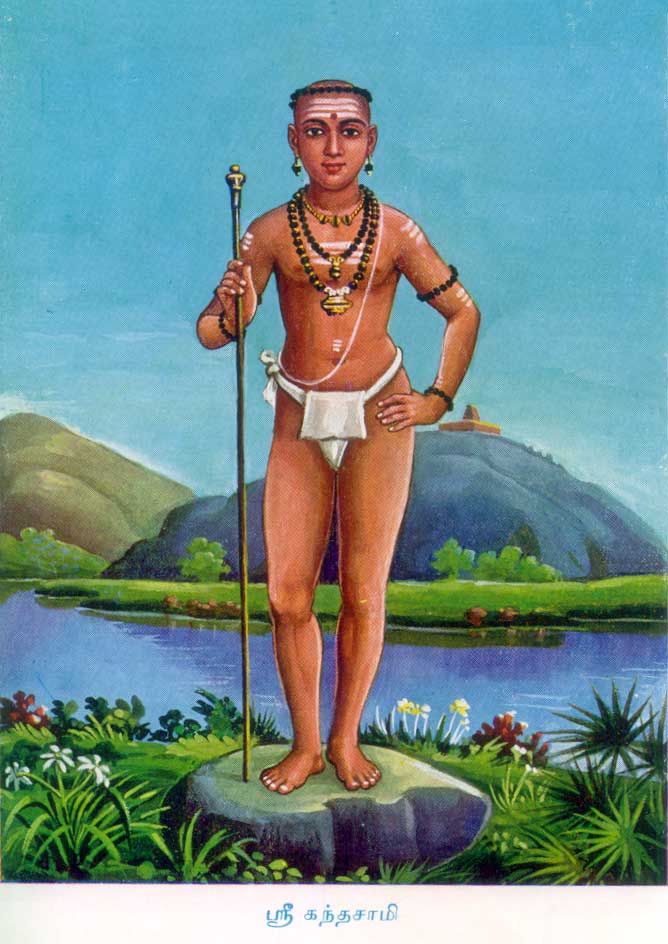
Above: Gurumūrti depicted as Mottayāndi, the shaven-headed mendicant
A number of specimens (Nos. 1023 to 1036) depicting Subrahmanya as Gurumūrti (the teacher) are available. When Brahma was imprisoned, Śiva asked Murugan as to whether he knew the meaning of pranava. When the answer came positively, Śiva took it from the mouth of Murugan by placing Himself as a student. Three specimens (Nos. 1029, 1034 and 1035) show Murugan in vīrāsana. He is two handed and holds the right hand in jnāna mudrā while the other is in varada mudrā or placed on the knee of the raised leg. Śiva stands before him with the front hands folded in anjali bandha or placing a front hand on his own lips in meek obedience as a student (Nos. 1034 and 1035). In the back hands Śiva bears the antelope and chisel. Śiva is adorned with ornaments, a pitāmbara and skandhamāla. In a number of panels, (Nos. 1030 to 1035) Gurumūrti is depicted as Mottayāndi (the shaven-headed mendicant). As Mottayāndi Murugan is said do have taken the beggar’s bowl in his hands, renouncing worldly life. In this condition most specimens illustrate him nude and shaven-headed wearing only a garland of kāsaya beads. Curiously enough, a specimen of the Mottayāndi type (No. 034) depicts him with the skandhamāla. In two other specimens, Gurumūrti appears as a child in the hands of Śiva (No. 1023) or a school boy (No 5025). In the latter specimens Gurumūrti is seated on a raised pedestal with the left leg in utkutika pose and the right hanging down. Rarely Parvati also stands along with Śiva. Śiva holds a long trident in the front left hand. Murugan turns his face towards the right ear of Śiva in whispering attitude.
Some of the panels deal with the romantic experiences of Murugan with Valli, leading to their marriage. The theme is very popular in Tamil folk dramas. Valli was the adopted daughter of a hunter chief, Nambi. She is considered to be the daughter of a deer and a rishi. A number of panels (Nos. 1045 to 1049) depict the episode connected with the birth of Valli. In them either a rishiis in sexual union with a deer or a deer cohabiting a girl. Two specimens (Nos.1046 and 1047) depict the intercourse between a deer and a rishi.The deer being very short, the rishi stands contracting his body downwards so as to enable the sexual organs to meet in union. In. another piece (No. l049) a lady stands like an animal placing her two hands on the ground. A male deer pounces upon her back in the rearing attitude and is trying coitus. In this motif the rishi is represented by the deer. Other specimens depicting the union of deers (No. 1045) or a rishi lying on a cot with an animal (deer?) on his lap (No. 1048) are also available. The artist here suggests that both were human beings who had sexual relations with one or both of them transformed into the deer form. 216 Other panels portray the romantic intercourse between Valli and Murugan. In one (No. 1051) he takes the left hand of Valli as a soothsayer to read palmistry. In another (No. 1050) he is in disguise as an old man and threatens Valli to give her consent to marry while Ganapati, transformed into an elephant, is chasing her. After much romance of this kind, they get married. In this form Murugan is known as Valli Kalyanasundaram or Valliparinayamūrti. A few specimens (Nos: 1052 and 1054) depict the matrimonial scene where Brahma and Visnu are present doing the agni cārya and kannikādāna respectively.
A few other specimens depict Murugan (Nos. 1057 to 1059) as Sarvalokaksanapradakshinamūrti (the Lord who circumambulated all the worlds within a second), as a cow-boy offering jujube to Avvaiyār (No. 1050), and Mottayāndi (Nos. 1060 to 1068). As a judge, Murugan is found seated and holding a balance. He is five or six-headed and twelve armed. In a rare panel, he is seated in the centre while the Ūrdhatāndavamūrti and Kā1i stand to his left and right respectively
1.26.3. Rare Forms
Murugan doing kaittālam (clapping) is a popular idiom in the Ūrdhatāndava panels of Śiva. In a rare piece (No. 1082) he is endowed with four heads, arranged in two tiers with three in first and one in second. He has twelve hands of which the front two are clapping.
In another piece (No. 1083) Murugan is endowed with three heads and twelve hands. Yet another specimen (No. 1089) depicts him with five heads and eight hands. Since the objects held in the specimens are illegible, the forms could not be identified. One among them (No. 1089) seems to be a form of Saurabheya Subrahmanya who is expected to be four faced and eight handed. 218 In two other specimens Sanmukha is seated on the peacock while the hands are arranged in circular (No. 1086) and semi-circular (No. 1084) forms. 219 In the latter specimen the heads themselves are arranged in a circular form with the result the middle face alone is visible while two other faces are partly visible.
In another panel (No. 1089) a standing figure of Sanmukha is depicted. Many of the hands in the specimen are found broken. But the figure seems to suggest that the six faced god is in a war-like posture as though holding an arrow, stringed to the bow. The heads of demons slayed by him are found scattered here and there in the panel.
In another rare piece (No. 1089), the polycephalous Sanmukha is seated in padmāsana). 220 He is endowed with twelve legs, all of which are arranged in the same seated posture. His heads are placed in three tiers with three in the first, two in the second and one in the third. The front two hands are displaying the varada and abhaya mudrās while the other hands are not visible.
Two other specimens depict Subrahmanya as seated on pedestal; in vīrāsana (No. 1090) and sukhāsana (No. 1085). Both are five faced. The former image is in the model of Daksināmurti and holds the front right hand in jnāna mudrā. The other image can be identified with Agnijāta Subrahmanya who is doing agni hotra. He is supposed to be two faced and eight handed — the sacrifcial ladle, rosary sword, the svastika, cock, shield, thunderbolt and ājya pātra in the hands. 221 In the specimen under consideration, Murugan holds the front right hand in the attitude of pouring ghee into the agni kunda (fire pit) found in front.
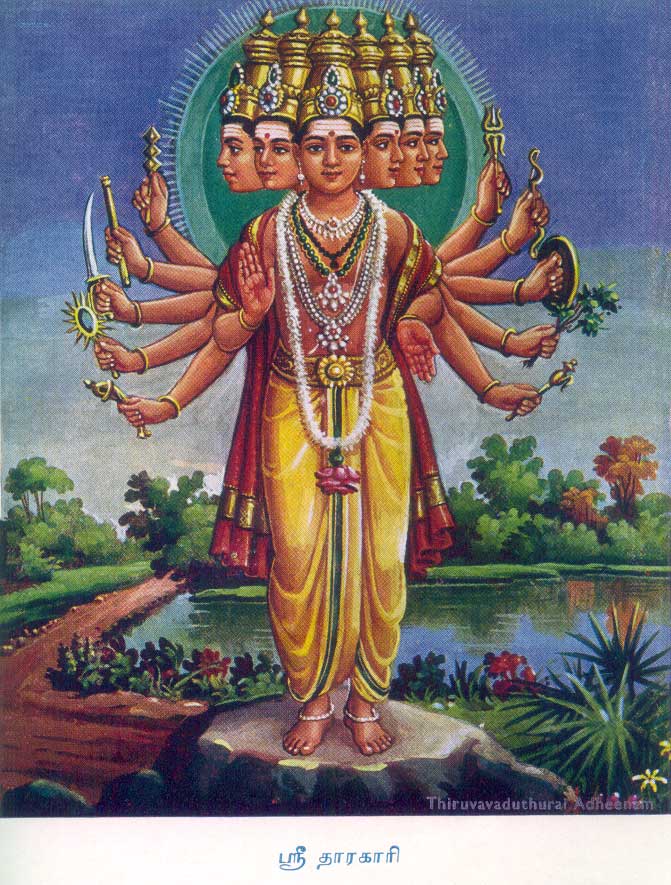
Tārakāri, Slayer of Tarakāsura
Kumāra or Murugan was by origin a war-like god. So most of his iconographical forms are related to belligerent activities. Devasenāpati Tārakāri, Krauncabhedakamūrti and Arunārūdamūrti are a few such. Being an epic hero, as presented in the Kumārasambhava of Kalidāsa, some of his forms are related to the birth of Kumāra also. In Tamil folk tales and dramas Murugan is a dynamic figure. Especially the episode connected with Valli is a theme of folk interest as frequently dramatised in country theatres. So some of the forms are on the subject of Murugan’s love-making with Valli. Similarly the anecdote connected with Avvaiyār, the Tamil poetess of repute, to whom Murugan is said to have offered jujube in the guise of a cowboy, is a popular one. Though these are not canonified forms, their portrayal in temple cars points out the value attached by artists to the regional variations of Kumāra mythology and folk taste.
To begin with, Murugan was a Tamil God 222 as he appears in Cankam literature. In the course of time the Murugan cult got mixed up with the Kumāra cult of North India. So in iconography the two sided personality of Kumāra is brought out in the delineation of Tamil forms such as Vallikalyanasundara and Northern forms such as Kumārasambhava. The mingling of iconographical forms under a common Murugan-Kumāra cult indicates the pan-Indian trends in cultural evolution which through the ages had developed, setting aside narrow territorial bias and linguistic barriers. Thus iconography through the ages had served as a medium for the spirit of cultural oneness and historical identity, contributing the needed incentives for North-South unity in the process of India’s ‘tryst’ with ‘destiny’.
End Notes
- B.S. Upadyaya. India in Kalidasa, p. 239.
- Śritatvanidhi. Pt. I.3. 117.
- lbid. 3.110. The disc, noose, cock, bow, shield, conch and plough may be replaced by a flag, club, bow, thunderbolt, lotus and kāka hasta in their respective places (E.M. Kandaswami Sarma ed. Kumaratantra. p. 21).
- Upendra Thakur, “Karttikeya in Literature, Art and Coins.” East and West, 24: 34 (Sep. Dec. 1974), pp.297310, Fig.2.
- The prabhamadala is spoken of only in connection with Skanda Sabrahmanya (Sritattvanidhi (Pt. I.3.103). Two images of Karttikeya with the plumage of peacock arranged in the prabhamadala fashion (8th century AD).) are found in the Bharat Kala Bhavan at Varanasi and the National Museum at New Delhi (Bhagawant Sahai. op. cit. p.110).
- Sarasvatiyacitrakarmařāstra. Ch. 38. vv. 5 to. Skanda as described by Sritattvanidhi (Pt. I, 3.103) is completely different. He is seared on a lotus. He has four hands bearing thunderbolt. (vajra) abhaya mudra, varada mudra and cock (kukkura).
- T.A. Gopinatha Rao. op. cit., I, Pt. II. pp.436-7.
- It comes closer to the Subrahmanya image in Cave I at Badami (R.S. Gupte, The Iconography of the Hindus Buddhists and Jains, Pl. XV, 83).
- Śritatvanidhi. Pt. l, 3.118.
- Kumāratantra. p. 20.
- T.A. Gopinatha Rao, op. cit. I, Pt. II, p.439.
- Śritvanidhi Pt. 1. 3. III. According to the Kumāratantra, he is twelve-armed.
- Ibid., 3.116. The Kumāratantra provides him six faces and eight arms.
- A similar episode is narrated in the Adiparvan of the Mahābhārata where a rishi and his patni (better half) had sexual union after a prolonged period of separation in the form of deers as they alone were supposed to derive the maximum gratification in coitus.
- Kumāratantra, p. 22.
- Śritatvanidhi, 1, 3. 105.
- This seems to be an impact of Tantric Buddhist iconography, wherein the arrangement of hands in such forms are very popular. (D.C. Bhattacharya. Tantrici Buddhist iconographic Sources, Fig. 15,Raju Kalidos, loc cit.)
- The identity is not clear. With reference to the left breast which looks like that of a lady, it can as well be identified with a rare from of Ardhanārisvara.
- Śritatvanidhi, Pt. I, 3, 104.
- Kamil V. Zvelebil, Smile of Murukan (Madras, 1981).
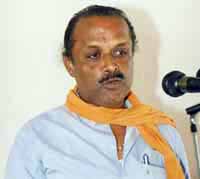
Dr. Raju Kalidos is Dean of the Arts Faculty and Head of the Department of Sculpture and Art History at the Tamil University, Tanjavur. He has published more than sixty articles on Indian iconography in distinguished academic journals of Europe and India. He has published and lectured extensively on topics of Indian sculpture, architecture and iconography and was voted ‘Man of the Year 1997’ by the American Biographical Institute.
- See these related articles by Raju Kalidos
- “Iconography of Skanda-Murukan: Flashes of Insight”
- Saptadasha-Subrahmanya: Seventeen Aspects of Skanda-Kumara
- “Trimurti Orientation in Medieval South Indian Temples“
Other articles about Kaumara Iconography and Art History
Karttikeya in ancient Cambodia
Karttikeya in ancient China
Skanda in Chinese Buddhism
Index of research articles on Skanda-Murukan
